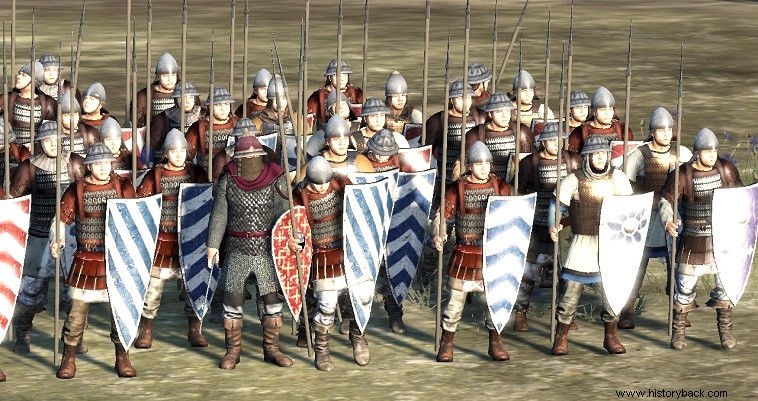
The spear is a weapon as old as mankind. Its history is lost in the depths of the centuries. It equipped our prehistoric ancestor in hunting and war as a formidable and unassailable weapon. Soon there was a differentiation between a light spear, suitable for throwing (javelin) and the heavier spear which was used exclusively for fighting from the cluster.
From the period of organization of the first state formations and the creation of armies the spear was one of the basic weapons of the soldiers as early as the 5th millennium . Information about satellites, i.e. men carrying a spear as their main weapon, is found in archaeological finds in Egypt, Mesopotamia and Greece and later also in northern Europe.
Along with the spear, similar tactics were adopted. So the Sumerians, around 2,500 BC. formed the first "phalanx" of satellites. The Egyptians, on the contrary, like most other Orientals, were mainly armed with javelins.
In Greece from the Minoan, Cycladic period, documented, the spear was the main weapon of the Greeks of the time. In the famous fresco of the "convoy", from the Akrotiri of Santorini, satellites are depicted, with long spears and foot shields. These long spears - sarissas, 3-3.5 m long, were called enghi.
In the East, after the Sumerians, the Akkadians and the Neo-Sumerian kingdoms used spears, until about the 18th century. BC In Greece, the spear continued to be used uninterruptedly in the Mycenaean era, initially in the form of the spear and then in the well-known form of classical times.
In the East, Assyrians, Babylonians, Medes and Persians used spears, as did the Chinese, in the Far East, but also the neighboring peoples influenced by them. In the West, the peoples who accepted the Greek influence, such as the Etruscans and the Romans, also had, for a long time, the spear as their main weapon. On the contrary, the peoples of "barbarian" Europe preferred the light spear - javelin, a weapon useful for hunting, in addition to war.
The Romans "rediscovered" the spear, equipping their auxiliary infantry and some of their units. In the Eastern Empire the spear had also been withdrawn from the infantry in favor of a lighter type of weapon that could be thrown, but also used from the cluster. But he soon found his place again and continued to equip the infantry of the Empire until its end.
Gradually, from the early medieval period, the spear armed divisions of satellites, literally, all over the world, becoming a truly universal weapon. In the East, his rule continued until the beginning of the 20th century. still. In the West it began to lose its value from the 15th century, when it was gradually replaced by the sarissa.
In the form of the sarissa, but also in its original form, the spear remained in service in European armies until the Napoleonic Wars, during which Russians and Prussians, in the absence of muskets, equipped their national guard units.
The spear was a blunt weapon, designed to pierce. Its long length was a significant advantage for its users over those armed with shorter weapons. This advantage was negated when an opponent approached the satellite at close range, in which case the spear was useless, as there was not the necessary distance from its target to use it.
It was soon understood that to maximize the effect of the weapon it was advisable for the satellites to act collectively, so that the adversary faced a "forest" of spikes. This is how the phalanx of satellites was born, which the Greeks perfected, with the use of the Oplos, the hoplite shield.
Unlike the Greek hoplite phalanx which had defensive and offensive power, most satellites of all eras and armies lacked serious strike power, but had great defensive power. The spear and the sarissa were also the basic weapons that provided significant defensive capabilities against cavalry y, which was the infantry's nightmare.
This never changed and it was only when the spear appeared that the spear and sarissa began to retire from the battlefields , which, adapted to the barrel of muskets, essentially constituted another form of spear.
In this form (bayonet), this primordial weapon remains, in fact, still in service, no longer for dealing with opposing horsemen, but for close combat against opposing infantry.
